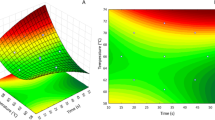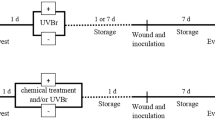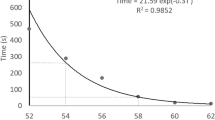Abstract
The demand for clean, safe and sustainable alternative control measures of postharvest diseases of fruit has increased in recent years, and the use of UV-C irradiation is a potential option. This study focused on evaluating UV-C dose effect on in vitro and in vivo development of fungi species and also on postharvest decay on mango cv. Tommy Atkins. The evaluated fungi which cause decay were as follows: Botryosphaeria dothidea, Lasiodiplodia theobromae, Alternaria alternata and Colletotrichum gloeosporioides. Fungus mycelium was exposed to increasing doses of UV-C irradiation: 0 (control), 2.0, 3.0, 5.0, 10.0 and 20 kJ m−2. L. theobromae and A. alternata received dose up to 59.7 kJ m−2. Mangos artificially inoculated with B. dothidea were treated with doses of UV-C irradiation: 0.0, 0.5, 1.0, 2.5, 5.0, 7.5 e 10.0 kJ m−2 and stored at 10 °C for 15 days and for 2 days at 22 °C, observing the rot on daily basis. The trials were conducted in a completely randomized design with six replicates for in vitro tests and four replicates with seven fruit as experimental unit. The in vitro trials demonstrated that even high dose of UV-C (20 kJ m−2) was not able to control the fungi development. Nonetheless, low dose of UV-C irradiation at 2.5 kJ m−2 controlled around 70 % of fruit rot severity. Higher doses (>5 kJ m−2) caused damage on mango peel increasing the rot severity. Results suggest that, the application of low dose (<3 kJ m−2) of UV-C irradiation can contribute to the integrated management of postharvest diseases on mango, and that, the mechanisms of control involved are not directly related to the fungi development.

Similar content being viewed by others
References
Alice Web Mercosul (2014). http://www.alicewebmercosul.mdic. Accessed July 8
Bartinick VA, Valdebenito-Sanhueza RM, Amarante CVT, Castro LAS, Rizzatti MR, Souza JAV (2010) Água aquecida e radiação UV-C no controle pós-colheita de Cryotosporiopsis perennans em maçã. Pesqui Agropecu Bras 45(2):124–131
Basseto E, Amorim L, Benato EA, Gonçalves F, Lourenço SA (2007) Effect of UV-C irradiation on postharvest control of brown rot (Monilinia fructicola) and soft rot (Rhizopus stolonifer) of peaches. Fitopatol Bras 32(5):393–399
Brown JE, Lu TY, Stevens C, Khan VA, Lu JY, Wilson CL, Collins DJ, Wilson MA, Igwegbe ECK, Chalutz E, Droby S (2001) The effect of low dose ultraviolet light-C seed treatment on induced resistance in cabbage to black rot (Xanthomonas campestris pv. campestris). Crop Prot 20(10):873–883
Bu J, Ni Z, Aisikaer G, Jiang Z, Khan ZU, Mou W, Ying T (2014) Postharvest ultraviolet-C irradiation suppressed Psy 1 ans Lcy-β expression and altered color phenotype in tomato (Solanum lycorpesicum) fruit. Postharvest Biol Technol 89:1–6
Bu J, Yu Y, Aisikaer G, Ying T (2013) Postharvest UV-C irradiation inhibits the production of ethylene and the activit of cell wall-degrading enzimes during softening of tomato (Lycopersicon esculentum L.) fruit. Postharvest Biol Technol 86:337–345
Charles MT, Benhamou N, Arul J (2008) Physiological basis of UV-C induced resistance to Botrytis cinerea in tomato fruit. Ш. Ultrastructural modification and their impact on fungal colonization. Postharvest Biol Technol 47(1):27–40
Charles MT, Makhlouf J, Arul J (2008) Physiological basis of UV-C induced resistance to Botrytis cinerea in tomato fruit: II. Modification of fruit surface and changes in fungal colonization. Postharvest Biol Technol 47(1):21–26
Cia P (2009) Tecnologias para o manuseio de doenças pós-colheita de produtos hortícolas. In: XLII Congresso Brasileiro de Fitopatologia. Tropical Plant Pathol, 34: XXV-XXVI
Cia P, Pascholati SF, Benato EA, Camili EC, Santos CA (2007) Effects of gamma and UV-C irradiation on the postharvest control of papaya anthracnose. Postharvest Biol Technol 43(3):366–373
FAO (2014). Food and Agriculture Organization of the United Nations. http://www.fao.org/corp/statistics Accessed July 8
Gonzales-Aguilar GA, Wang CY, Buta JG, Krizek DT (2001) Use of UV-C irradiation to prevent decay and maintain postharvest quality of ripe `Tommy Atkins’ mangoes. Int J Food Sci Technol 36(7):767–773
Khademi O, Zamani Z, Poor Ahmadi E, Kalantari S (2013) Effect of UV-C radiation on postharvest physiology of persimmon fruit (Diospyros kaki Thunb.) cv. “Karaj” during storage at cold temperature. Int Food Res J 20(1):247
Schenk M, Guerrero S, Alzamora SM (2008) Response of some microorganisms to ultraviolet treatment on fresh-cut pear. Food Bioprocess Tech 1:384–392
Sharma N, Tripathi A (2008) Integrated management of postharvest Fusarium rot of gladiolus corms using hot water, UV-C and Hyptis suaveolens (L.) Poit. Essential oil. Postharvest Biol Technol 47(2):246–254
Stevens C, Liu J, Khan VA, Lu JY, Kabwe MK, Wilson CL, Igwegbe ECK, Chalutz E, Droby S (2004) The effects of low-dose ultraviolet light-C treatment on polygalacturonase activity, delay ripening and Rhizopus soft rot development of tomatoes. Crop Protect 23(6):551–554
Acknowledgments
The authors wish to thank the São Paulo Research Foundation (Fundação de Amparo à Pesquisa do Estado de São Paulo—FAPESP: 2011/23432-8) for financial support for this research.
Author information
Authors and Affiliations
Corresponding author
Rights and permissions
About this article
Cite this article
Terao, D., de Carvalho Campos, J.S., Benato, E.A. et al. Alternative Strategy on Control of Postharvest Diseases of Mango (Mangifera indica L.) by Use of Low Dose of Ultraviolet-C Irradiation. Food Eng Rev 7, 171–175 (2015). https://doi.org/10.1007/s12393-014-9089-4
Received:
Accepted:
Published:
Issue Date:
DOI: https://doi.org/10.1007/s12393-014-9089-4




